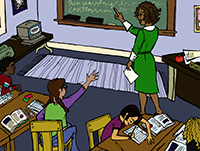What does Ms. Milton need to know about students with visual impairments?
Page 3: How Visual Impairments Impact Learning
 Now that Ms. Milton better understands the visual functioning that Evan and Emily experience in their daily lives, she feels more prepared to include them in her classroom. Still, she wonders how having visual disabilities will affect the ways in which Evan and Emily will learn new concepts and skills. She is especially concerned about how Evan, who is blind, will learn about things that he cannot see. Ms. Milton is also concerned about how she will present new concepts and how these accommodations might affect her lesson plans and teaching style.
Now that Ms. Milton better understands the visual functioning that Evan and Emily experience in their daily lives, she feels more prepared to include them in her classroom. Still, she wonders how having visual disabilities will affect the ways in which Evan and Emily will learn new concepts and skills. She is especially concerned about how Evan, who is blind, will learn about things that he cannot see. Ms. Milton is also concerned about how she will present new concepts and how these accommodations might affect her lesson plans and teaching style.
Concept Development
Concepts are ideas or mental images created through interactions in an environment. The understanding of specific concepts is developed through a process of classifying or grouping similar things (e.g., beagles, poodles, and golden retrievers are all dogs) and through discriminating categories of concepts (e.g., dogs are not cats). Children often learn new concepts naturally through:
- Direct interaction
- Observation
- Reading
- Pictures
- Television
- Verbal explanations
Impact of Visual Impairment on Concept Development
Understanding how visual impairments impact concept development will help Ms. Milton teach Evan and Emily more effectively. Some researchers estimate that 90% of what young children learn is acquired through visual experiences. Now that Ms. Milton has learned something about Evan’s and Emily’s visual abilities, she can focus on effective ways to present information that would otherwise be learned visually.
Teaching students with visual disabilities can be challenging for three reasons.
 For one, students with sight learn simply by observing the world around them (e.g., watching fireworks bursting or birds flying). This is known as incidental learning. Similar concepts must be directly taught to children with visual impairments.
For one, students with sight learn simply by observing the world around them (e.g., watching fireworks bursting or birds flying). This is known as incidental learning. Similar concepts must be directly taught to children with visual impairments.
 Second, vision enables individuals to quickly take in a lot of information and gather the whole picture. On the other hand, learning through touch, which is sometimes the primary method for visually impaired children, requires students to first learn about the parts before putting them together to create the full entity (e.g., looking at a tree instead of touching its leaves, branches, or bark). This is known as part-to-whole learning.
Second, vision enables individuals to quickly take in a lot of information and gather the whole picture. On the other hand, learning through touch, which is sometimes the primary method for visually impaired children, requires students to first learn about the parts before putting them together to create the full entity (e.g., looking at a tree instead of touching its leaves, branches, or bark). This is known as part-to-whole learning.
 Lastly, some environmental concepts that are easily observed are typically unavailable for children to touch due to physical access or safety issues (e.g., elk in the zoo). In such cases, teachers may have to rely on a combination of verbal explanations, realistic models, books about the particular animal, and other related experiences (e.g., a trip to a natural history museum to touch a preserved animal).
Lastly, some environmental concepts that are easily observed are typically unavailable for children to touch due to physical access or safety issues (e.g., elk in the zoo). In such cases, teachers may have to rely on a combination of verbal explanations, realistic models, books about the particular animal, and other related experiences (e.g., a trip to a natural history museum to touch a preserved animal).
Ms. Milton must keep in mind that children who are blind or have low vision use other sensory information to learn about the world around them.
Strategies to Support Concept Development
 Teachers can support conceptual learning for students with visual disabilities by providing meaningful opportunities for hands-on interactions with real items. For example, during geography lessons, a topographic globe for Evan and Emily would be a helpful learning tool. Likewise, when teaching money concepts, she should use real money because of its true texture, weight, and feel, rather than using imitation currency.
Teachers can support conceptual learning for students with visual disabilities by providing meaningful opportunities for hands-on interactions with real items. For example, during geography lessons, a topographic globe for Evan and Emily would be a helpful learning tool. Likewise, when teaching money concepts, she should use real money because of its true texture, weight, and feel, rather than using imitation currency.
Activity
The 1999 MGM film At First Sight features Val Kilmer as Virgil, a man who is blind and who—at the prompting of his girlfriend Amy (Mira Sorvino)—undergoes surgery to regain his sight. Take two hours to watch the film, and then discuss how it portrays blindness, Virgil’s compensatory skills, and the other characters’ reactions to Virgil’s visual disability.